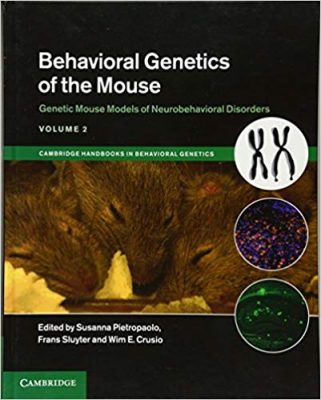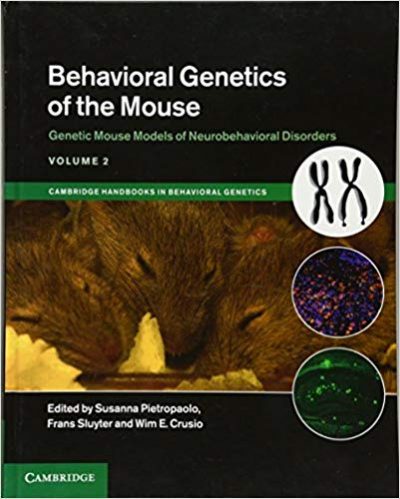 Editors: Susanna Pietropaolo, Frans Sluyter, and Wim E. Crusio
Editors: Susanna Pietropaolo, Frans Sluyter, and Wim E. Crusio
Publisher: Cambridge University Press- 457 pages
Book Review by: Sonu Chandiram
This second volume of Behavioral Genetics of the Mouse published in 2014 provides a comprehensive overview of the major genetically modified mouse lines to model human neurobehavioral disorders of various kinds, as detailed in the titles of its chapters below.
Sixty-two specialists in: abuse research, alcohol research, behavioral sciences, biochemistry, biomedical sciences, brain technology, cognition and emotion research, genetics, microbiology, molecular genetics, neurology, neuroscience, neuro-toxicology, ophthalmology and visual sciences, pain medicine, pharmacology, psychiatry, psychology, physiology, translational research, and other related fields – from 15 countries – Australia, Canada, China, France, Germany, Israel, Italy, Japan, the Netherlands, Russia, Spain, Sweden, Switzerland, the United Kingdom, and the United States – authored the 32 chapters of this book, listed below:
- Section 1– Introduction to genetic mouse models of neurobehavioral disorders
- Introduction: Genetic mouse models of neuropsychiatric disorders
- Developing mouse models of neurobehavioral disorders: When is a model a good model?
- Section 2 – Perception disorders
- Pain disorders
- Disorders of the visual system
- Section 3 – Autonomous and motor disorders
- Obesity and anorexia
- Sleep disorders
- Cerebellar disorders
- Motor disorders
- Epilepsy
- Section 4 – Social dysfunction and mental retardation
- Pathological aggression
- Disorders of sex
- Autism
- Rett syndrome
- Fragile X syndrome
- Attention-deficit hyperactivity disorder
- Obsessive-compulsive disorder and Gilles de la Tourette syndrome
- Schizophrenia
- Down syndrome
- Prader-Willi and Angleman syndromes
- Williams syndrome
- Section 5 – Anxiety and mood disorders
- Anxiety disorders
- Depression
- Bipolar disorder
- Section 6 – Substance dependence and abuse
- Alcohol-use disorders
- Drug abuse: Nicotine
- Cannabis abuse and dependence
- Drug abuse: Amphetamines
- Cocaine-related disorders
- Opioids-related disorders
- Section 7 – Neurodegenerative disorders
- Alzheimer’s disease
- Parkinson’s disease
- Huntington’s disease
The use of animals as ‘models’ to study a disorder in humans has been in use for a long time now. When it comes to studying behavioral disorders in humans, mice are very often the animals of choice among researchers.
In their Introduction: Genetic mouse models of neuropsychiatric disorders, the editors point out:
“Animal modeling is an interactive process in which one or more ‘species’ are studied to gain insight on a trait or disorder in humans including the testing of (new) hypotheses and (pharmaco) therapies. Roughly speaking, a model’s usefulness depends on the strength of its validity, which as three components: face, predictive, and construct validity. These, in turn, depend on the information we have about the trait or disorder.”
Why are mice often used as models to study human disorders? These are some of the reasons:
- Rapid advances in genetic engineering over the last two decades, and as a result, there are numerous ‘distinct mouse techniques’ available to mimic (or test hypotheses on) the pathophysiology of a disorder.
- The brains and genomes of mice are similar to those of humans
- The genetic causes of neuro-developmental disorders such as Rett syndrome and Fragile X syndrome (as discussed in chapters 13 and 14) are known and these disorders can be reliably modeled using genetically engineered mice.
- Genetic mouse models are also helpful in modeling the effects of rare genetic variants. An example of this is the 2010 study of Bevilacqua et al who discovered an association between impulsivity and the gene coding for 5-HT2B receptor in a Finnish subpopulation
This book in short is a pioneering endeavor of its editors to find the causes of behavioral disorders by researching with mice as models. It is exciting when scientists open up new knowledge vistas!
Editors:
Susanna Pietropaolo is a researcher at the Centre National de la Recherche Scientifique (CNRS). She is an expert in the behavior analysis of the laboratory mouse, with a special interest in social behaviors. Her recent research focuses on the mouse models of social dysfunction, including autism and Fragile X Syndrome
Frans Sluyter is an expert in wild house mouse behavior and neurogenetics at the University of Portsmouth in the United Kingdom. His interests range from aggression, addiction, depression and stress-coping strategies to gene expression profiles and consciousness. He has worked in France, Japan, the Netherlands, and the United Kingdom.
Wim E. Crusio is a Research Director at the Centre National de la Recherche Scientifique (CNRS). With over 40 years experience in mouse behavioral genetics and the analysis of mouse behavior, his recent interests cover mouse models of depression, autism, and Fragile X Syndrome.






